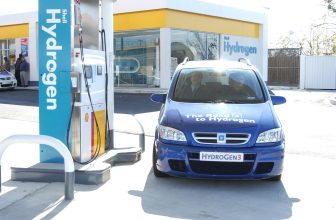
Around 15,000 hydrogen powered passenger vehicles exist now, mostly in California. Growth of this alternative to fossil fuels could help fight climate change. Image: United States Department of Energy
By Jake Christie
Researchers have located a promising underground region in the Midwest that could have stores of fuel.
But they’re not looking for oil. They’re looking for hydrogen.
Hydrogen reservoirs form when heated water meets with iron rich rocks. An ancient North American rift could have created such environments, said Geoffrey Ellis, a United States Geologic Survey researcher.
Natural hydrogen is a climate-friendly alternative to oil as it only produces water when it is used, rather than the harmful greenhouse gases produced by oil, according to the International Energy Agency.
Over 1 billion years ago, North America split along a curve that extends up from Michigan, into Canada and then down through Minnesota, Wisconsin and Iowa before ending in Kansas.
A recent model made by Ellis, suggests the Mid-Continent Rift may mean there is more hydrogen available within the earth’s crust than we thought.
The rift is a prime candidate for more research, said Ellis, whose model was presented at a Geological Society of America conference in October.
States the rift runs through that produce petroleum, like Michigan, aren’t likely to have reservoirs of hydrogen, Ellis said. Hydrogen is consumed as a part of the natural process that forms petroleum.
But non-petroleum producers like Minnesota and Wisconsin might, Ellis said. More research is needed.
Engineers can’t simply modify existing methods of finding oil and gas to find hydrogen, Ellis said. That helps, but it will also require pulling from multiple disciplines.
“There’s some elements of mineral exploration that will be helpful for hydrogen exploration, as well as geothermal resource exploration.”

Shifting tectonic plates produced a large rift in the upper Midwest, creating an environment likely to produce hydrogen. Image: United States Geological Survey
While finding hydrogen requires new methods and a lot of effort, using it will not.
Most hydrogen we use is created from natural gas. It is used to refine petroleum and to produce ammonia for fertilizer, said Keith Wipke, the Fuel Cell and Hydrogen Laboratory program manager for the National Renewable Energy Laboratory.
Hydrogen used in refining and production is created near where it’s used. That means there’s no infrastructure for transporting hydrogen long distances, Ellis said.
That makes hydrogen costly to move, even though there are a few attempts to establish that infrastructure, according to the International Energy Agency.
Natural gas and hydrogen can be transported together through existing natural gas pipelines with minor modifications, but only around 20% of the mixture can be hydrogen, Ellis said.
Hydrogen power likely won’t replace electric power in passenger vehicles entirely, Ellis said.
But it’s better suited than batteries to power large vehicles that need to travel long distances like semi-trucks. That’s because hydrogen refuels much faster than batteries recharge, Wipke said.
Hydrogen could also heat blast furnaces used for steel manufacturing as it is difficult to reach high enough temperatures to smelt steel with electricity, Ellis said.
Bringing hydrogen to market might be just as difficult as finding it.
“We kind of have a chicken and the egg problem,” Ellis said.” People don’t want to put a lot of effort into exploring for it if they can’t sell it, and people don’t want to set up a system for bringing it to market if it’s not available.”
Editor’s note: This story was corrected April 1, 2023 to accurately report the use of most hydrogen.